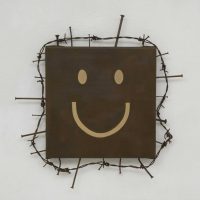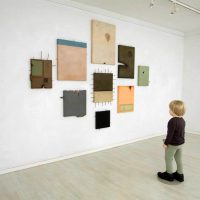His works have not once provoked the indignation of the public. His work is an organic oeuvre and a complex motifsystem which regarding its inner mechanism and scandalous visuality is close to the international tendency headed by Chapman Brothers or Maurizio Cattelan.
In his ambivalent world, the intimacy of the subject is delusive, the position taken by the ‘unfolding’ artist is a tricky, self and general, dupery which – by even attacking common courtesy – is searching for a way-out towards artistic liberty exempt from demagogies… and when realising that all is just an illusion, it starts the destruction of the artworks themselves.
The traces of this last phase were already visible at Győrffy’s ‘retro(necro)spective’ exhibition at the Szent István Király Museum in Székesfehérvár. By now this idea of destruction became represented in a much more vigorous way within the present installation which is to be exhibited in Várfok Project Room.
The exhibition entitled My Pain Is Your Gain reflects as Győrffy’s previous works on the position of contemporary art and contemporary artist and also on the viewer’s reflexes – but in a much stronger way. One part of the installation is based on suicidal abstract paintings, more precisely pictureobjects organically installed on the wall:
‘Continuing the ‘abstract’ experiment started last year I was interested in paintings which destruct, destroy, deconstruct themselves in a way that the structure of the picture is disturbed by physical deformations, injuries and alien objects (nails, blades, screws etc.).
The sculpture, a child (= viewer) masturbating in his trousers, generates a disturbance in the exhibition space and beyond that deconstructs the topos of the suffering artist. In the same time the title (The Angel of Revenge) refers to the possibility of an intervention descending from a transcendental dimension; the oversized penis of the child refers to an inhuman entity.
The tension caused by these elements culminates in the absurd logic of the grotesque border transgression: the blur of notions like magnificent and ridiculous, saint and profane, living and lifeless not only evokes the Freudian theory about life and death instincts but also questions modernism’s promise of redeeming.’
László Győrffy



